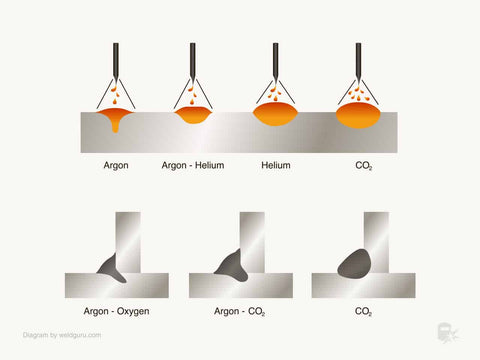What's the difference between MIG & MAG Welding?
Jan 02, 2024
MIG (Metal Inert Gas) welding and MAG (Metal Active Gas) welding are both arc welding processes that utilize a continuous solid wire electrode to join metals. The primary difference between MIG and MAG welding lies in the type of shielding gas used during the welding process.

MIG Welding:
- Shielding Gas: MIG welding uses inert gases such as argon or helium as shielding gases. These gases do not react with the molten metal, providing a stable arc and protecting the weld from atmospheric contamination.
- Application: MIG welding is suitable for welding non-ferrous metals like aluminum, copper, and stainless steel, as well as mild steel.
MAG Welding:
- Shielding Gas: MAG welding, on the other hand, employs active gases, typically a mixture of carbon dioxide (CO2) and argon or other gases. These active gases react with the molten metal, offering better penetration and higher welding speeds.
- Application: MAG welding is commonly used for welding ferrous metals, especially carbon steels.
Shared Characteristics:
- Both processes involve the use of a continuous wire electrode that is fed through a welding gun.
- The heat generated by an electric arc melts the wire, which is deposited onto the workpieces, creating a weld pool that solidifies to form the final weld.
Key Considerations:
- The choice between MIG and MAG welding depends on factors such as the type of materials being welded, the desired welding speed, and the specific requirements of the welding application.
- MIG welding is favored for its clean and precise welds, making it suitable for applications where appearance is crucial.
- MAG welding, with its higher penetration capability, is often chosen for thicker materials and structural welding applications.

In summary, while MIG and MAG welding share similarities in terms of the welding process, the choice between the two depends on the type of shielding gas used and the specific welding requirements for the materials being joined.
| Gas | Advantages | |
| MIG |
● Argon ● Helium |
● Welds are protected from chemical reactions ● Produces an exceptionally high-quality product ● Produces clean, clear welds free from oxidation ● Can be used to weld non-ferrous metals such as aluminium ● Readily automated and integrated into robotic welding systems |
|
MAG |
● Nitrogen ● Oxygen ● Hydrogen ● Chlorine ● Carbon dioxide |
● Low cost and ready availability of active gas ● Can produce increased weld penetration ● Can produce high heat and temperatures ● Can weld ferrous metals such as steel ● Easily automated and integrated into robotic welding systems |
Here are a few of the key considerations when deciding whether MIG or MAG welding is best for your needs:
● MAG welding is more cost-effective than MIG welding
● MAG welding provides more penetrating power
● MAG welding is best used on thicker, ferrous metals like steel
● MIG welding is more accurate and precise than MAG welding
● MIG welding is best used on thinner, non-ferrous metals such as aluminium



